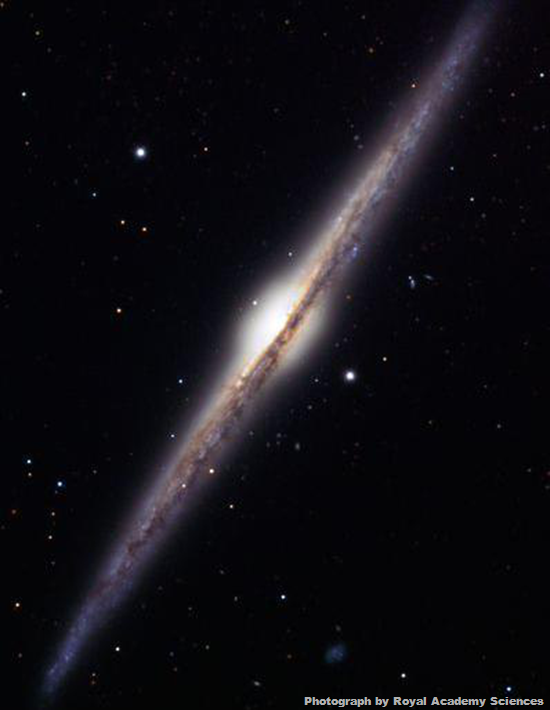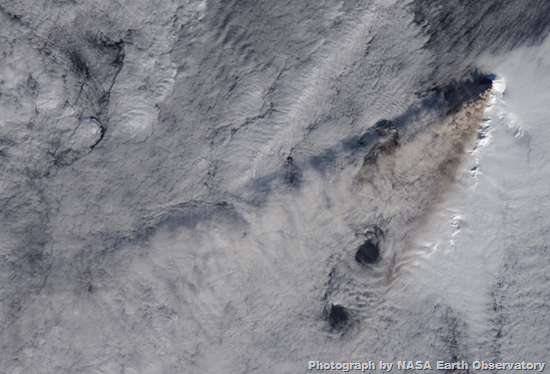
Week's Best Space Pictures: A Giant Erupts, a Glacier Spills, and Janus Hovers
By Jane J. Lee, National Geographic News, 20 February 2015.
By Jane J. Lee, National Geographic News, 20 February 2015.
A volcano awakens after seven years, a river of ice and snow spills onto a plain, and a Saturnian moon hovers near some rings in this week's best space pictures.
1. A Disruptive Disk
Our solar system makes makes a leisurely circuit every 250 million years around the galactic disk (above) of the Milky Way. But the route is not straightforward; our sun dips in and out of the disk every 30 million years.
Biologist Michael Rampino at New York University speculates that this passage may be related to mass extinctions on Earth - like the one that wiped out all dinosaurs except for birds 65 million years ago. Cometary impacts are one explanation, among several, scientists use to explain these mass extinctions.
Disruptions - such as those caused by passing stars - in the Oort cloud, a debris field in the outer reaches of our solar system, can propel comets toward Earth. Rampino now believes that dark matter can also rattle this cloud every time our solar system wanders through the galactic disk.
2. Spillover
The Elephant Foot Glacier in northeastern Greenland (above, centre) is known as a piedmont glacier. Such flows form when a glacier spills over from a steep valley onto a plain, much like pancake batter spreads out on a hot griddle. Piedmont glaciers are known for their symmetry, with Elephant Foot being the best example. (Read about glacial meltdown in National Geographic magazine.)
3. A Dark Guide to Black Holes
Black holes sit at the centre of every massive galaxy, a dark heart that researchers now believe is shaped by its surrounding cloud of dark matter. Astronomers observed the relationship between the two in looking at elliptical galaxies, formed when smaller galaxies merge into a football shape that contains their combined dark matter.
It's unclear how dark matter guides the growth of these black holes, but new findings indicate that the more dark matter a galaxy contains, the bigger its black hole is. (See "Winds Blasting From Black Holes Shut Down Star Growth.")
4. Magnetic 3-D Images
NASA's Magnetospheric Multiscale (MMS) mission awaits an early March launch date in a clean room - a pollutant-, dust-, and microbe-free environment - in Titusville, Florida. The MMS consists of four identical spacecraft that will record a three-dimensional view of the magnetic fields surrounding Earth, the sun, and other stars.
Researchers hope to learn how these fields connect and break apart. Some reconnections can release huge amounts of energy in explosive events.
5. An Ephemeral Connection
Saturn's rings sweep across the corner of an image taken by the Cassini spacecraft. Janus, one of Saturn's moons, hovers below. The rings and the moon are linked together through the barest of gravitational pulls. (See "Distant World Has Rings 200 Times Bigger Than the Rings of Saturn.")
6. The Giant Awakens
The Chikurachki volcano erupted after seven years of silence on February 16. Located on Paramushir Island south of Kamchatka in the northern Pacific, Chikurachki is a stratovolcano, the most deadly type of volcano. Stratovolcanoes are known for explosive eruptions accompanied by pyroclastic flows - outpourings of hot volcanic gas and debris that can hurtle down a slope at hurricane-force speeds.
Photo gallery by Nicole Werbeck.






No comments:
Post a Comment
Please adhere to proper blog etiquette when posting your comments. This blog owner will exercise his absolution discretion in allowing or rejecting any comments that are deemed seditious, defamatory, libelous, racist, vulgar, insulting, and other remarks that exhibit similar characteristics. If you insist on using anonymous comments, please write your name or other IDs at the end of your message.